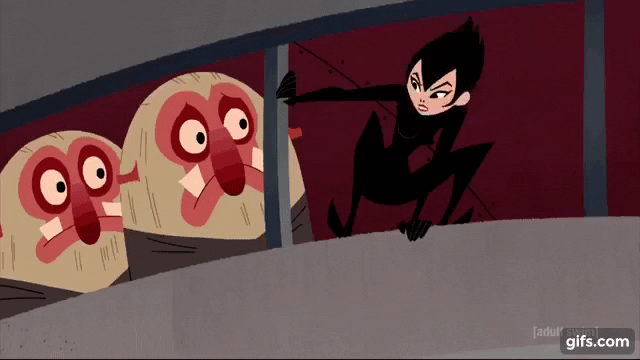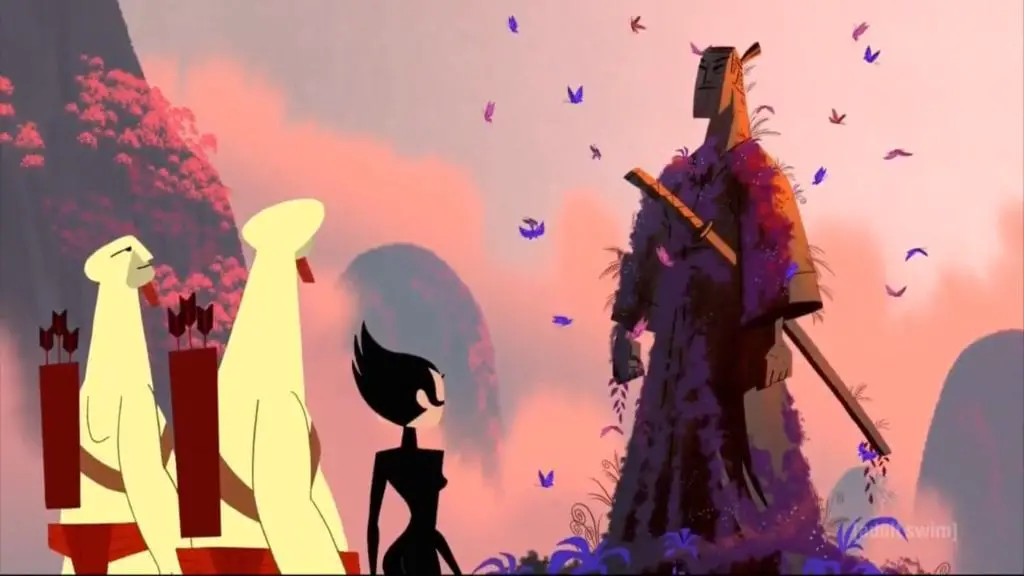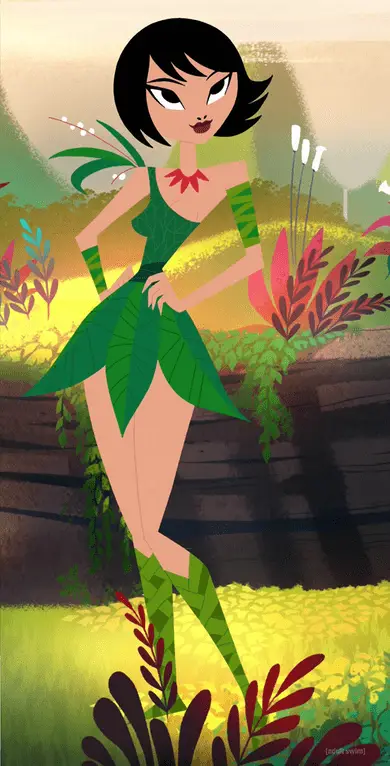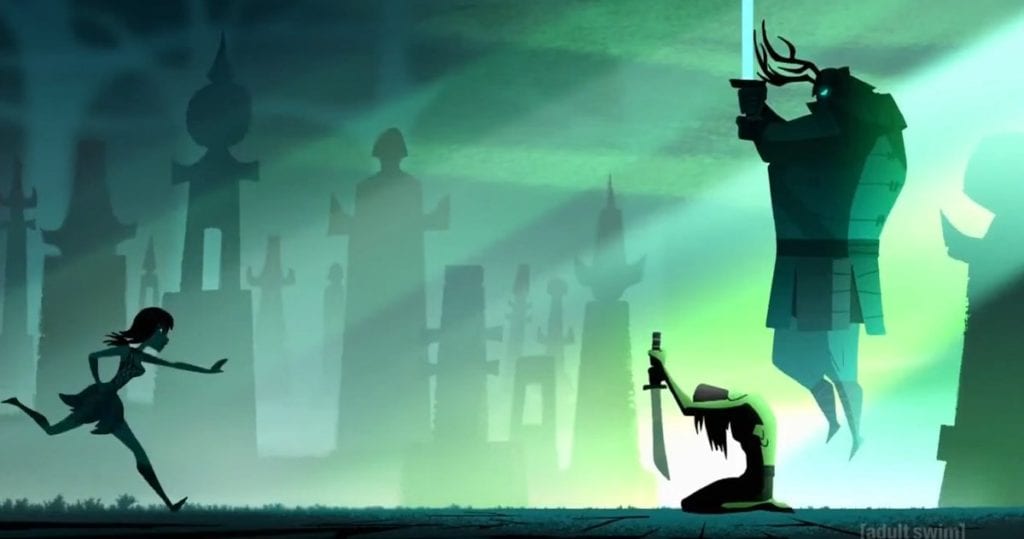The sixth episode of Samurai Jack’s final season brings us something new. Not only does it follow Ashi more than Jack himself, but it carries a powerful message of hope in the face of the despair that had battered at our heroes in the previous episode.
It opens with Ashi hitching a ride on an airship. She’s recognized by a pair of robe-clad figures, who believe she’s still hunting Jack. They attack her to protect him, but she quickly assures them that she means to help the samurai.
The robed figures reveal themselves to be…Woolies (Cameron: “So adorable!!!”). The large, hairy creatures from the very beginning of the series. Jack freed them from slavery to diminutive Chritchellites, and they’re still grateful to him fifty years later. Ashi thanks them for their story, and leaves to seek Jack…by jumping out of the airship.

This encounter sets the tone for Ashi’s segment in this episode. The next ones follow its pattern. After leaving the airship, Ashi runs into beetle-drones, fleeing after someone riddled them with arrows. Viewers with a good memory may recognize those arrows — and indeed, those who fired them are the formerly-blind archers.
Once Ashi declares her desire to help Jack, they tell Ashi how he had freed them from their curse, and at the cost of a chance to return to the past. They revere his sacrifice to this day, fight Aku, and will come to the samurai’s aid should he need it. Ashi once again moves on.

Ashi’s third encounter is of a different sort. She walks into a large crowd of dancers, and asks if they’ve seen Jack. This gets the attention of the DJ, who leads the crowd in a song and dance about how Jack once freed them from a mind-controlling rave. The DJ is Olivia, in fact, who was once one of the enslaved children. The dancers make an “S” sign with their hands, and imitate the dance Jack had performed so long ago. Ashi joins in, uncertain at first, and then enjoying herself. Then she vows once more to find Jack and leaves.
One of the show’s most disturbing scenes is of the flashback explaining how the sisters got their suits. Naked, they were then thrown into pits of a black dust, perhaps charcoal, pumice, or even dust, to imitate Aku’s blackness. It again shows how brutal Ashi’s life was, but also how she’s trying to recover and move past it. Using rocks, she scrapes off the suit, cleaning herself of the suit and in a symbolic way, of Aku too.
What follows is a very short shot of her swimming naked and clean in the cave. The shots are shockingly, and amazingly, non-exploitative. So often moments like these are used for blatant fanservice with lingering shots on boobs and butts. Instead we have a tasteful and light set of shots focusing on how clean she is. This alone set the show apart from so much of cartoon canon and is actually pretty subversive.
Since Ashi literally washed away her clothes, as she is now naked. So she does the most natural thing one would do and creates an entirely new outfit out of leaves. It’s amazing how this moment was so funny considering the gross child abuse we saw only moments before.

Her outfit links her more to nature. So when she confronts Jack at the end, she shows him how she turned over a new ‘leaf’ and is now seeing the truth because of him. It further links itself to the theme of legacy in the episode and showcases Ashi’s growth as a character.
The fourth callback to the original series has a still different tone. Ashi enters a seedy bar operated by none other than the braggart Jack had once taught the meaning of being a samurai. He tells her how Jack had beaten him and deflated his ego. Being a bartender isn’t much of a step up, but at least he’s no longer a bully. The mercenaries in the bar think Ashi wants to hunt down Jack, and tell her how he had demolished them in combat. Thus, this memory is less about Jack’s virtue and more about his power. Then we get a brief cameo from Demongo, who seeks to amass souls of warriors again, but leaves when it turns out there aren’t any good ones in the bar. After Ashi leaves, a small figure points her in the right direction, but we’re not sure who it was.
All of this boils down to one thing, though: Jack’s journey mattered. He made a difference, even if he doesn’t feel this way after fifty years of hopeless struggle. He left behind a trail of people who owe their life and their hopes to him. They remember him. None of it was in vain.
We see his legacy poured into every part of the episode. Whether it’s his statue created by the formerly blind archers and their village who will happily fight for him, the bodyguard Woolies who would protect his life, or the dance he helped to create, the man has a legacy.
And he really needs to be told that, when Ashi finally finds him. He’s sitting in the middle of a graveyard, getting ready to commit seppuku. The Horseman (or rather, the Omen, as the credits call him) is there was well. The spirit declares him a failure, and calls spirits of other warriors to witness his penance. He takes his place behind Jack, ready to behead him once he plunges the blade into his stomach, all part of the seppuku ceremony.

Ashi will have none of that, of course. She tells Jack about everything she’d seen: the people who still remember him and think of him as a hero. Jack himself says nothing, the confrontation is between Ashi and the Omen. The former stands for his hope, and the latter, his despair. The Omen tries to kill Ashi to silence her, insisting that Jack wash his dishonor away with his blood. Finally, when he accuses Jack of failing to save the lives of children, Ashi catches him in a lie: the children survived. And that’s it for Jack. He rises and kills the Omen before he can strike down Ashi. In this way, he saves her, but not before she’d already saved him.
We still don’t know what the Omen is, even as Jack destroys him. Was he a spirit of an ancient Samurai, out to punish Jack for failing to uphold the warrior’s code? He seemed too outwardly malicious for that. He lied to him about the children’s deaths, and when Ashi corrected him, he only redoubled his efforts to kill her. It’s not something an honorable warrior would do. So what was he? A phantom who wanted to take Jack into the afterlife? Or something else entirely? Perhaps it was a Shinigami?
Once the Omen is gone, Jack awkwardly compliments Ashi’s new outfit and hair. Oh, Jack. You’re a great warrior, but interacting with people was never your strong suit. Still, when Ashi asks him what’s next, the samurai’s answer is clear. He has to find his sword again.
Overview
This episode was, well we’ve already used excellent quite a bit. How about masterful? It was masterful in everything: thematics, character growth, witty callbacks, use of symbolism. Frankly, we could probably spend an article talking about the bath scene alone. This show continues to improve itself and wow us in ways we’d never expect. We can’t wait for the next episode to see what it brings.
Images Courtesy of Cartoon Network
[starbox id=“Cameron,Michał”]

